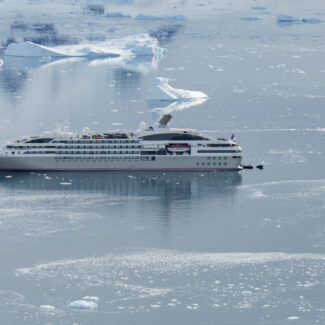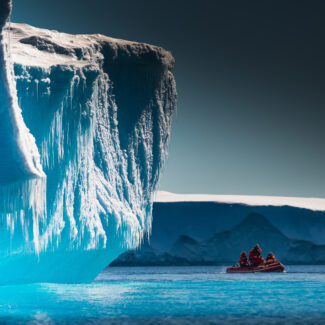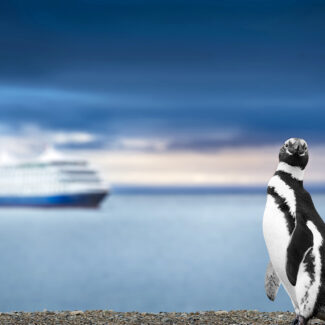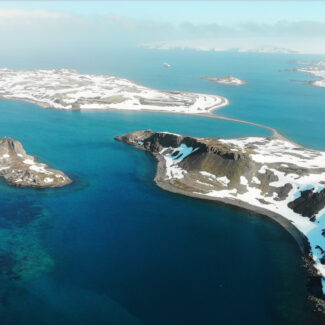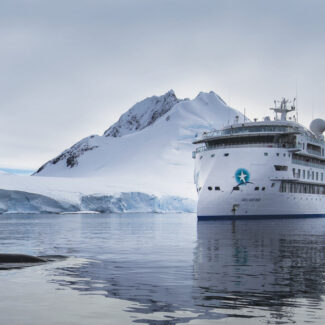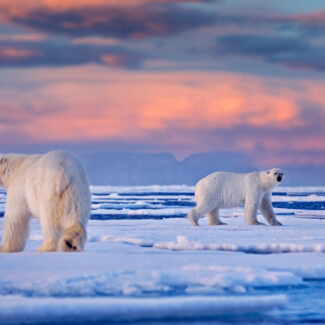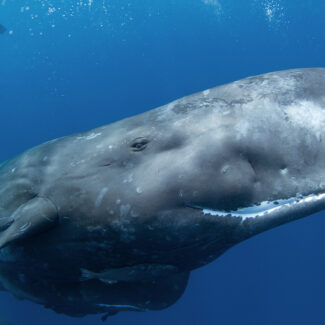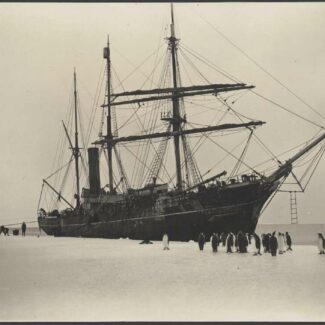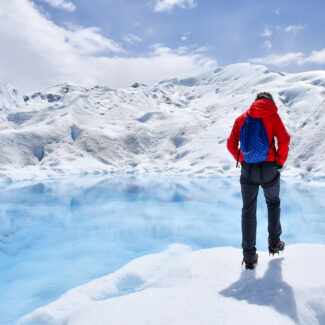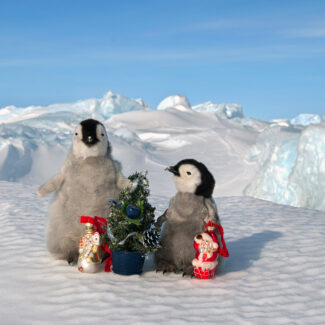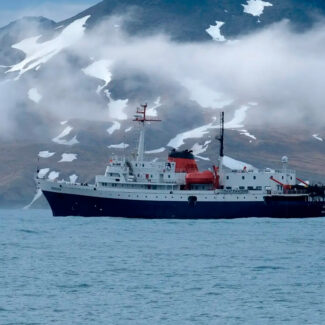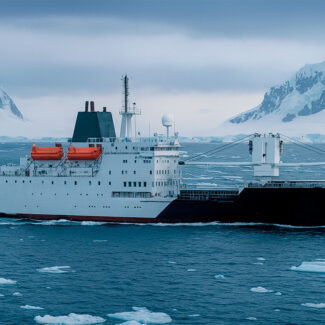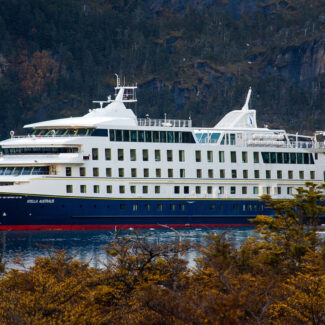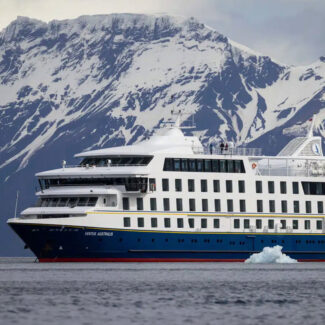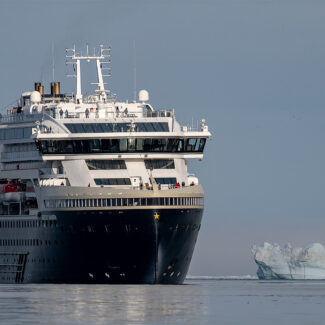What Is A "White Whale"? 10 Interesting Beluga Whale Facts
- (1) They Go By a Number of Different Names: From White Whale to Sea Canary
- (2) They’ve Got a Unique Bodyplan, Geared Toward the Arctic Environment
- (3) They’re Known For Their Striking White Hide—and Shed Their Skin Each Year
- (4) They Swim a Broad Arctic & Subarctic Range, and Many Populations are Migratory
- (5) They’ve Got the Most Intricate Vocalizations Known Among Whales
- (6) They’ve Got a Varied Diet of Fish & Invertebrates
- (7) They Sometimes Show Up Well Outside Their Typical Geography
- (8) They’re Relatively Long-Lived, But Face Some Significant Predators—and Varied Impacts From Humanity
- (9) Despite Their Nickname, They Have Nothing To Do With the Figurative Phrase “White Whale”
- (10) You Can (With Luck) See Beluga Whales On An Arctic Cruise
Among the most recognizable and endearing marine mammals in the world, the beluga whale is a linchpin of the Arctic marine ecosystem—and always a special thrill to see in the wild. Many folks, after all, have seen these “white whales” in captivity, as they’re often displayed in aquariums and oceanariums around the world. But it’s a whole other experience to glimpse belugas in their natural habitat, spouting along an ice front or tundra coast.
Let’s learn more about this marvelous cetacean via the following interesting facts about beluga whales!
(1) They Go By a Number of Different Names: From White Whale to Sea Canary
The word beluga stems from the Russian belukha, which means “white whale”—which, indeed, is another widely used common name for this creature. Among indigenous monikers for the cetacean are keelaluga (Yupik), sisuaq (Inupiat), and kooyedyee (Tlingit).
A familiar nickname, meanwhile, is “sea canary” or “canary of the sea,” which nods to the beluga’s rich and melodic suite of vocalizations, which we’ll dig into shortly.
The beluga’s genus name, Dephinapterus, means “dolphin without a fin,” a reference to the animal’s lack of a dorsal fin (more on that in a bit, also!).
Known by many names, from “white whale” to “sea canary,” this incredible creature embodies the mystery and wonder of the Arctic, truly living up to its varied monikers!
(2) They’ve Got a Unique Bodyplan, Geared Toward the Arctic Environment
Belugas are medium-sized toothed whales, typically growing to maximum sizes of 10 to 16 feet or so and weighing 3,000 pounds or more. Males are notably larger than females.
Belugas have streamlined but somewhat lumpy bodies, with stubby but broad, paddle-like flippers that upcurl with age and a notched tail that becomes convex in maturity. As the aforementioned genus name conveys, the beluga—like its close relative the narwhal—lacks a dorsal fin, instead boasting a subtle dorsal ridge. As in the narwhal, this is thought to be partly an adaptation for under-ice living; a dorsal fin obviously gets in the way if you’re spending a lot of time cruising below sea-ice cover, and the dorsal ridge may be employed to break apart thinner ice layers. The lack of a dorsal fin might also help belugas, which are Arctic and sub-Arctic specialists, reduce heat loss.
Besides the snowy shade of its hide, the beluga’s foremost physical characteristic is its bulbous “forehead”: a body part known as the melon, which contains air sacs that assist in broadcasting its ornate vocalizations. The neck vertebrae of belugas aren’t fused, which allows this whale more flexible head movement than is seen in many cetaceans.
The beluga’s body is about 40 to 50% body fat: an impressive proportion boosting insulation and mirrored in the two other year-round Arctic whales, narwhals and bowheads.
Perfectly adapted to the Arctic, the beluga’s streamlined body allows it to navigate icy waters with remarkable agility. Their unique form truly is a marvel of evolution!
(3) They’re Known For Their Striking White Hide—and Shed Their Skin Each Year
The beluga is the palest of all cetaceans, but that trademark white color comes with age: Calves are grayish, pink-brown, or blueish. The ivory hue presumably gives the white whale a measure of camouflage amid sea ice and snow, which defines the bulk of its winter habitat—and which, notably, hosts prowling polar bears (and Native human hunters).
Belugas undergo a summertime molt, during which they shed off old, yellowed outer skin to reveal a fresh new white layer below. They commonly rub themselves upon seafloor and riverbed gravel to exfoliate.
The beluga’s iconic white hide, so striking in Arctic waters, is actually shed annually! This amazing process helps them maintain their pristine appearance and adapt to their environment.
(4) They Swim a Broad Arctic & Subarctic Range, and Many Populations are Migratory
Belugas inhabit a broad expanse of the Arctic Ocean as well as adjacent sub-Arctic and even northern temperate waters; they reach 47 degrees latitude in the St. Lawrence Estuary, the southernmost extent of their core range. They’re primarily found in Alaskan, Canadian, Greenland, and Russian waters as well as in the Norwegian archipelago of Svalbard, the global population of perhaps 140,000 (a rough estimate) split among numerous distinct sub-populations or stocks—for example, five defined stocks in Alaska and seven in Canada. These stocks range widely in size: some in the tens of thousands, some—such as the belugas of the St. Lawrence Estuary, Alaska’s Cook Inlet, and Svalbard—only in the hundreds.
Belugas are remarkably versatile in the Arctic and sub-Arctic habitats they utilize: from deep offshore waters to shallow coastal zones and even freshwater rivers such as the Amur and Mackenzie. A beluga was recorded more than 800 miles up the Yukon River. Their prominent use of coastal lagoons, estuaries, and rivers isn’t entirely understood, but may correspond with fish runs and/or the favorability of these waters for calving, molting, and avoidance of predators. Although certain sub-populations are fairly resident, others are migratory, covering hundreds or thousands of miles across the course of a year. Such migratory belugas typically range between winter habitat out in the sea ice—where they may be found several hundred miles from the nearest large stretches of open waters, utilizing leads and polynyas (large open-water gaps in the sea ice) to breathe—to summertime range in coastal realms and estuaries. The distinct beluga migration routes followed by different populations may be passed down from mother to calf.
Examples of migratory sub-populations include the Eastern High Arctic-Baffin Bay stock, which ranges between summer range in Barrow Strait, Peel Sound, and Baffin Bay and wintering grounds in northern Baffin Bay, western Greenland waters, and the North Water Polynya (the biggest of its kind in the Arctic). Some belugas wintering in the Bering Sea, meanwhile, travel better than 1,500 miles to summer in the delta of the Mackenzie River in Canada.
Beluga pods are typically fairly small, often consisting of 10 or fewer individuals, but in summer—as in such estuary hangouts as the Mackenzie River Delta—they may gather together in herds that can number more than a thousand.
Witness a beluga pod’s incredible journey! These Arctic nomads undertake vast migrations, navigating icy waters to cover their broad subarctic range with remarkable endurance.
(5) They’ve Got the Most Intricate Vocalizations Known Among Whales
Belugas boast the most complex and varied repertoire of vocalizations yet recorded among cetaceans: from clicks and chirps to whistles, twitters, and squeals. These can be loud indeed, audible even above-water when white whales are near—hence early sailors giving them the whole “sea-canary” tag. Scientists have speculated that this diverse toolkit of sounds—which are used for finding prey via echolocation as well as to communicate with other belugas—may, in part, reflect the beluga’s occupation of so many kinds of aquatic environments, from ice-covered pelagic depths to nearshore shallows and river mouths.
Researchers in Russia and Canada have documented geographic variation in beluga contact calls and other vocalizations across sub-populations, with—perhaps unsurprisingly—the most extreme differences evident between the farthest-apart stocks.
Often called “canaries of the sea,” belugas produce an astonishing array of complex vocalizations. This intelligent whale’s unique head shape helps it create and direct its intricate sounds.
(6) They’ve Got a Varied Diet of Fish & Invertebrates
Belugas have quite a diverse diet founded on invertebrates—from clams, snails, and sandworms to octopus and squid—and fish, with commonly scarfed species including cod, smelt, salmon, and herring. The whales’ blunt teeth aren’t too much help in processing such prey, which is probably mostly swallowed whole.
Belugas make frequent, and usually relatively short, dives to feed; they’ve been recorded diving past 2,800 feet. While much beluga foraging seems to be an individual endeavor, the white whales also cooperate to herd and corral fish.
With a varied diet of fish and invertebrates, this agile beluga is a master hunter of the Arctic seas. Its healthy appearance reflects the abundance of its icy feeding grounds.
(7) They Sometimes Show Up Well Outside Their Typical Geography
Although, as mentioned, the St. Lawrence Estuary in Canada hosts the southernmost stock of belugas in the world, the white whales are also well known for periodically drifting into lower-latitude waters. These occurrences are examples of what biologists call vagrant or extralimital animals, which may be swimming far outside normal territory for any number of reasons: sent off-course by a powerful storm, aimlessly swimming in poor health, or perhaps simply yearning to explore.
Belugas have, for example, shown up in British waters—including the Thames Estuary—as well as the North Sea coast of Germany, Japan, New Jersey along the U.S. Atlantic Seaboard, and, along the Pacific coast of the U.S., within Puget Sound and even—in a 2020 record that marks the farthest south a beluga has ever been officially logged—off San Diego in Southern California.
While typically Arctic inhabitants, beluga whales sometimes surprise us by appearing far from home! Their adventurous spirit reminds us of the ocean’s vast, interconnected wonders.
(8) They’re Relatively Long-Lived, But Face Some Significant Predators—and Varied Impacts From Humanity
Belugas commonly live to 40 or more years old, with some individuals getting north of eight decades.
In terms of natural predators of the beluga, the most significant is the orca, or killer whale. Orcas have been observed preying on white whales in most corners of the latter’s distribution, sometimes killing multiple belugas from a pod or herd in a single event. This mortality factor may be increasing, too, as sea-ice loss in the Arctic expands the orca’s range there. A common tactic employed by killer whales is violently ramming belugas, which likely causes severe damage to bones and internal organs. Some have speculated that at least one reason why belugas often enter estuaries and rivers is to avoid orcas.
Traveling far under pack ice, as belugas are adapted to do, may also help them steer clear of killer whales, but such habitat exposes them to another formidable predator: the polar bear. Along with scavenging or killing stranded belugas, polar bears sometimes manage to snatch whales surfacing within leads and other gaps in the sea ice and drag them out of the water; they’ve even been seen apparently attempting to catch whales by swimming. While beached (or ice-trapped) belugas of any size are vulnerable to polar bears, presumably calves and juveniles are most often taken in, or from, the water.
Commonly gathering in easily accessible coastal and estuarine waters, belugas have long been hunted by humans on both a subsistence and commercial basis across their Arctic and sub-Arctic domain, and people have also killed them out of concern the white whales were decimating commercially valuable fish populations. Other anthropogenic threats to belugas include pollution—a significant cause of concern for white whales in the St. Lawrence Estuary, for example—and, of course, climate change, which may threaten the species by affecting ocean temperatures, sea-ice patterns, and food sources.
Although the International Union for the Conservation of Nature (IUCN) classifies the beluga globally as a “Least Concern” species, certain sub-populations—such as the Cook Inlet stock, which decreased by close to 80 percent between 1979 and 2018 and numbers today only some 300-odd whales—are considered endangered.
Even these long-lived belugas face formidable predators like polar bears. This striking image reminds us of the delicate balance of the Arctic ecosystem and the challenges belugas endure.
(9) Despite Their Nickname, They Have Nothing To Do With the Figurative Phrase “White Whale”
Despite common misconception, surprisingly the slang meaning of “white whale”—an objective that is obsessively pursued but often difficult to achieve—does not derive from the beluga whale.
It does, however, have something to do with whales, deriving directly from Herman Melville’s 1851 novel, Moby-Dick, in which the main character—the monomaniacal Captain Ahab—obsessively hunts a formidable albino sperm whale named Moby Dick, which ultimately leads to his destruction.
While Moby Dick was literally Ahab’s white whale, the phrase has now become part of the modern day lexicon to figuratively represent any deeply coveted yet elusive goal or object.
While beluga whales are indeed known as “white whales”, they are a significantly smaller species of toothed whale compared to the colossal Moby Dick. The infamous white whale of Melville’s epic was, in fact, a sperm whale (the largest of all toothed whales), a creature of immense power, capable of ramming and sinking whaling ships—a fate which became of the American whaler Essex in the Pacific Ocean on 20th November, 1820, when an enormous male sperm did exactly that, shocking the world’s press and inspiring Melville’s seminal novel in the process.
Though often called “white whales,” these incredible creatures are far from the elusive, obsessive quest of fiction. They are real, vibrant inhabitants of our polar seas.
(10) You Can (With Luck) See Beluga Whales On An Arctic Cruise
Travelers in many corners of the Arctic have at least the chance to spy belugas, from West Greenland to Russia’s Franz Josef Land archipelago. The Canadian High Arctic supports abundant beluga stocks, so a cruise through the Northwest Passage, for example, may yield sightings. Alaska is another prime destination for beluga-watching, not only along the Arctic coast but also far south in the Cook Inlet, right near the capital of Anchorage. The isolated beluga population in Svalbard makes that Arctic island group another great place to see the species; belugas often congregate right along the Svalbard coastlines in summer, which, of course, is peak cruise-going season.
So, will spying a Beluga in the wild become your white whale, or will you be lucky enough to see one?
Imagine the thrill of spotting a pod of beluga whales on an Arctic cruise! These majestic “white whales” are a highlight of a journey into the breathtaking, icy wilderness.
Disclaimer
Our travel guides are for informational purposes only. While we aim to provide accurate and up-to-date information, Antarctica Cruises makes no representations as to the accuracy or completeness of any information in our guides or found by following any link on this site.
Antarctica Cruises cannot and will not accept responsibility for any omissions or inaccuracies, or for any consequences arising therefrom, including any losses, injuries, or damages resulting from the display or use of this information.


